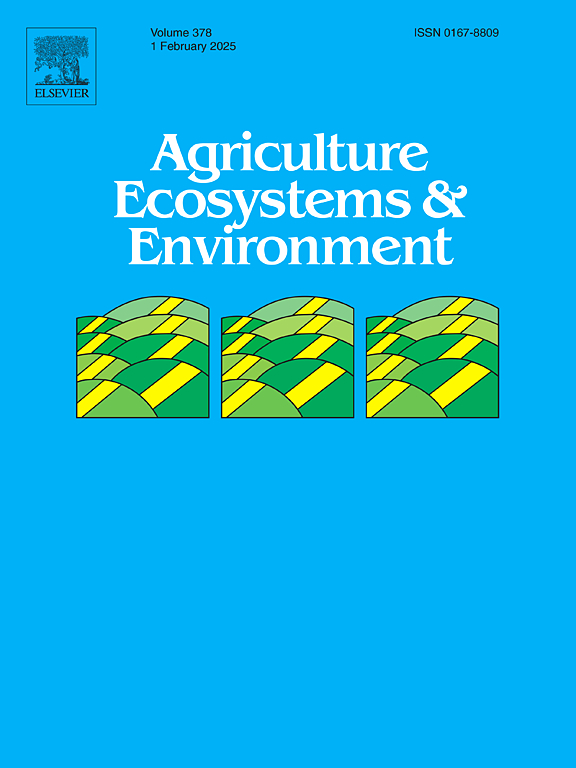Climate-driven alterations reshape flower coloration and possible plant-pollinator interactions in wet grasslands
IF 6
1区 农林科学
Q1 AGRICULTURE, MULTIDISCIPLINARY
引用次数: 0
Abstract
Climate change is a global phenomenon that has a significant impact on ecosystems. In this study, we investigated whether extreme climatic events associated with global warming are altering the composition of insect-pollinated plant species and whether this is leading to exacerbated changes resulting from the disruption of plant-pollinator interactions. We conducted an experiment to artificially induce extreme climate conditions, which allowed us to analyse their impact on the flower colour composition of vegetation communities. The experiment was carried out in a wet grassland. We measured flowering phenology and flower colour visual signals of bees and flies (hue, saturation, and brightness) under the influence of simulated changes in environmental conditions. The results showed that additional irrigation and passive warming accelerated the onset of flowering and reduced the number of flowering insect-pollinated species over the growing season. Additional irrigation, increased temperature, and their interaction increased flower saturation of bee and fly visual spaces, and decreased saturation in butterfly visual space colour within the analysed plots. We also found that changes in water availability can lead to selective pressures that favour different flower colour traits, potentially affecting the overall dynamics of pollinator interactions. Additional irrigation reduced the proportion of bee-green and fly-yellow plant species. Warming without additional irrigation increased the proportion of bee-green species, but decreased the proportion of bee-UV-green and fly-UV cover plants. Moreover, the analysed factors and their interaction drive changes in the composition of plant communities that shape hue perception patterns in butterflies. These results highlight the complexity of ecosystem responses to climate-related factors, where multiple interacting variables can lead to unexpected changes in floral traits, such as changes in flower colour saturation of different pollinator groups or shifts in dominant hues, ultimately impacting pollinator behaviour and potentially overall biodiversity.
气候驱动的变化重塑了湿润草原上花朵的颜色和可能的植物与传粉者的相互作用
气候变化是一种对生态系统产生重大影响的全球现象。在这项研究中,我们调查了与全球变暖相关的极端气候事件是否正在改变昆虫传粉植物物种的组成,以及这是否导致植物与传粉者相互作用的破坏而导致变化加剧。我们进行了人工诱导极端气候条件的实验,分析了极端气候条件对植被群落花色组成的影响。实验是在潮湿的草原上进行的。在模拟环境条件变化的影响下,我们测量了蜜蜂和苍蝇的开花物候和花的颜色视觉信号(色调、饱和度和亮度)。结果表明:在整个生长季节,额外灌溉和被动增温加速了开花的发生,减少了开花昆虫传粉物种的数量。额外灌溉、温度升高及其相互作用增加了蜜蜂和苍蝇视觉空间的花朵饱和度,降低了蝴蝶视觉空间颜色的饱和度。我们还发现,水分供应的变化可能导致有利于不同花色性状的选择压力,从而潜在地影响传粉媒介相互作用的整体动态。额外的灌溉减少了蜂绿色和蝇黄色植物种类的比例。增温不加灌溉增加了蜂绿植物的比例,但降低了蜂绿植物和蝇紫外覆盖植物的比例。此外,所分析的因素及其相互作用驱动了蝴蝶色彩感知模式形成的植物群落组成的变化。这些结果突出了生态系统对气候相关因素响应的复杂性,其中多个相互作用的变量可能导致花性状的意外变化,例如不同传粉者群体的花朵颜色饱和度的变化或主导色调的变化,最终影响传粉者的行为和潜在的整体生物多样性。
本文章由计算机程序翻译,如有差异,请以英文原文为准。
求助全文
约1分钟内获得全文
求助全文
来源期刊

Agriculture, Ecosystems & Environment
环境科学-环境科学
CiteScore
11.70
自引率
9.10%
发文量
392
审稿时长
26 days
期刊介绍:
Agriculture, Ecosystems and Environment publishes scientific articles dealing with the interface between agroecosystems and the natural environment, specifically how agriculture influences the environment and how changes in that environment impact agroecosystems. Preference is given to papers from experimental and observational research at the field, system or landscape level, from studies that enhance our understanding of processes using data-based biophysical modelling, and papers that bridge scientific disciplines and integrate knowledge. All papers should be placed in an international or wide comparative context.
 求助内容:
求助内容: 应助结果提醒方式:
应助结果提醒方式:


